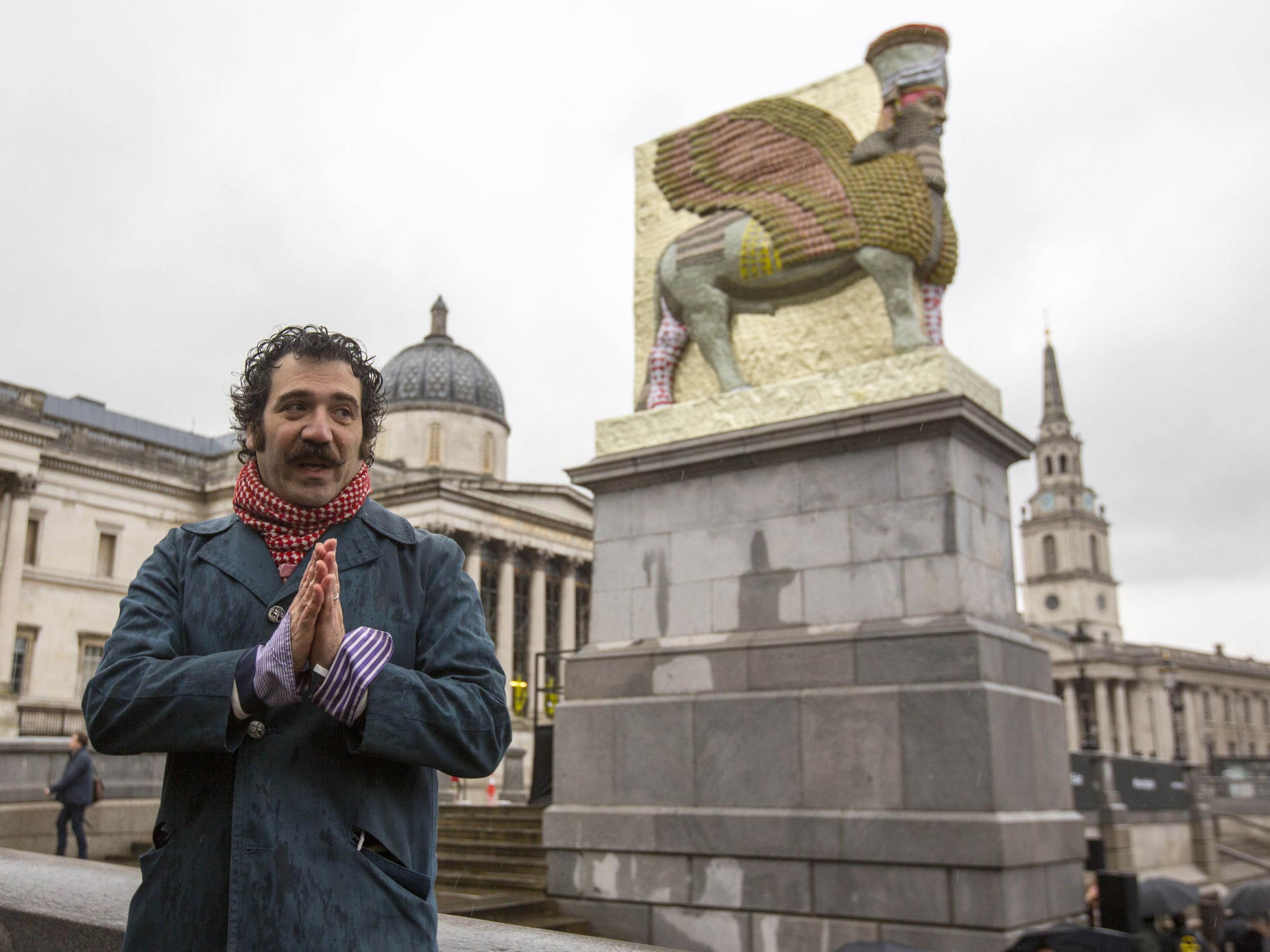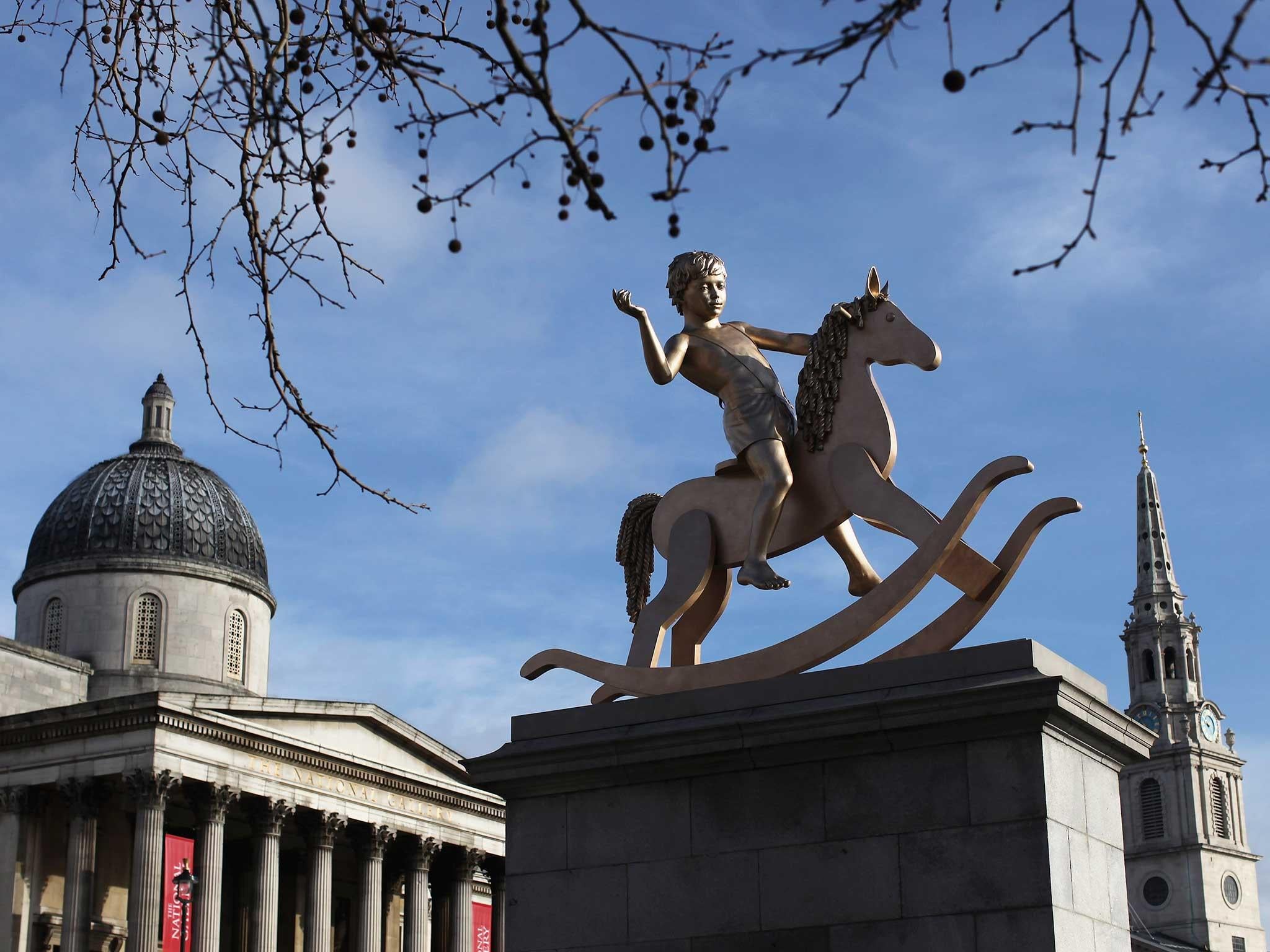Fourth Plinth: Recreation of ancient winged bull statue destroyed by Isis takes pride of place in Trafalgar Square
Michael Rakowitz installation resurrects mythological beast that guarded Assyrian city of Nineveh for more than a thousand years using 6,000 cans of date syrup

Your support helps us to tell the story
From reproductive rights to climate change to Big Tech, The Independent is on the ground when the story is developing. Whether it's investigating the financials of Elon Musk's pro-Trump PAC or producing our latest documentary, 'The A Word', which shines a light on the American women fighting for reproductive rights, we know how important it is to parse out the facts from the messaging.
At such a critical moment in US history, we need reporters on the ground. Your donation allows us to keep sending journalists to speak to both sides of the story.
The Independent is trusted by Americans across the entire political spectrum. And unlike many other quality news outlets, we choose not to lock Americans out of our reporting and analysis with paywalls. We believe quality journalism should be available to everyone, paid for by those who can afford it.
Your support makes all the difference.A recreation of an ancient winged bull statue destroyed by Isis in Iraq has been unveiled as the latest installation to perch atop the famous Fourth Plinth in London's Trafalgar Square.
Iraqi-American artist Michael Rakowitz, 44, has chosen to revive an ancient Assyrian statue destroyed by the group in February 2015 in an act of wanton cultural terrorism intended to provoke the West.
The Invisible Enemy Should Not Exist is a sculpture of a lamassu, a mythological winged bull creature with the head of a man that stood guard over the city of Nineveh for over a thousand years until it was desecrated by the militants' power drills.
The piece will be positioned on the plinth facing south east - looking back towards Nineveh - and is constructed from 6,000 tin cans of date syrup; the lamassu reborn from the sort of ordinary objects that comprise the fabric of everyday life.
Dates were one of Iraq's most important exports before the industry was decimated by two successive Gulf Wars. The unorthodox materials nod to Rakowitz's own history, his family emigrating to San Francisco in 1946 and retaining ties to their troubled homeland thanks to his grandfather's import-export business.
The artist has continued to engage with Iraqi subject matter throughout his career.
His current undertaking sees him recreate all 7,000 items looted from the National Museum of Iraq during the 2003 invasion of the country led by the US to topple dictator Saddam Hussein.
His controversial 2011 project Spoils meanwhile saw him acquire 18 of Hussein's own dinner plates from a US military veteran on eBay and use them to serve a traditional Iraqi venison dish in a New York restaurant.
The US State Department subsequently intervened on diplomatic grounds and confiscated the crockery before the then-US president, Barack Obama, returned them to Baghdad.
The Invisible Enemy Should Not Exist is only the latest conceptual artwork to take pride of place in front of the National Gallery.
The Fourth Plinth has provided an ever-changing free exhibition space since the first artwork appeared in 1999.

Unlike the capital's permanent fixtures - the Henry Moore in front of King's Cross Station, say, or the figures of historic leaders declaiming in Parliament Square - the Fourth Plinth installations never risk disappearing into the backdrop, forgotten by all Londoners bar the pigeons as they scurry past the same old monuments. The view is always new and seldom boring.
The plinth was designed by Sir Charles Barry in 1841 and intended for a figure on horseback to join George IV in Trafalgar Square's north east corner (British military stalwarts Sir Charles Napier and Henry Havelock occupy the others).
It stood empty for more than 150 years, however, after funding for a statue of King William IV (1765-1837) fell through and Britain was left debating an alternative.

It was not until 1998 that the Royal Society for the Encouragement of Arts, Manufactures and Commerce (RSA) commissioned three contemporary sculptures as a stopgap solution, with the-then culture secretary, Chris Smith, commissioning famed barrister and novelist Sir John Mortimer to undertake a public inquiry on the best possible use of the platform.
Mortimer concluded that the public would ideally prefer a rolling conveyor belt of new works rather one fixed figure.
Responsibility for the ownership of Trafalgar Square was transferred from Westminster City Council to the Mayor of London's office in 2005, at which point the programme flourished.
Notable works have included Antony Gormley's One & Other (2009) - in which ordinary members of the public took turns to spend an hour standing on it, free to do as they wish; Yinka Sonibare's self-explanatory Nelson's Ship in a Bottle (2010-12); Katharina Fritsch's giant blue cockerel (2013-15); Hans Haacke's skeletal horse (in tribute to painter George Stubbs); and, most recently, David Shrigley's bronze thumbs-up, Really Good (2016-18).
Raskowitz's Invisible Enemy is one of the most overtly political and striking works to take the stand, a timely statement of defiance against global terror from a city that has withstood several devastating attacks in recent years and remains unbowed.
Join our commenting forum
Join thought-provoking conversations, follow other Independent readers and see their replies
Comments